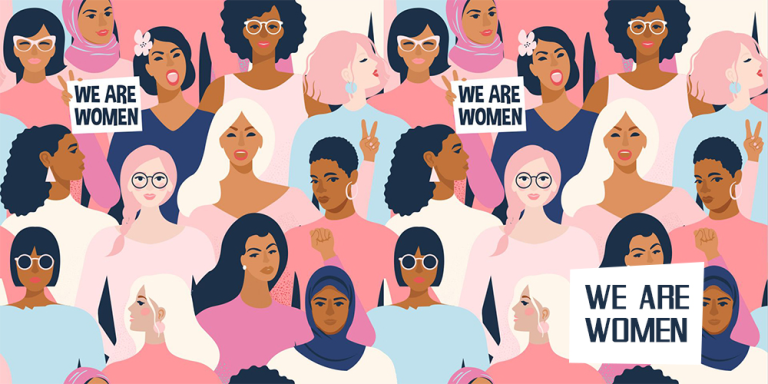In data collection, analysis, and use, it’s common practice to classify women and girls as one homogeneous group.
But it’s become increasingly clear that doing so fails to capture the diverse array of challenges women and girls face globally, drowning out specific needs in favor of generalizable data.
While many of the issues women face are the same, the ways in which they experience them are different. As Black poet and feminist writer Audre Lorde states: “The oppression of women knows no ethnic or racial boundaries, true, but that does not mean it is identical within those differences.”[1] She illustrates an irrefutable point that applies across the spectrum of our identities: race, ethnicity, nationality, gender identity, sexual orientation, and socioeconomic class all play significant roles in the way women and girls individually view and experience the world.
Nothing has made that clearer than the coronavirus pandemic in the U.S., which has brutally exposed the intersections of gender and racial inequities in our society, specifically for women of color. Women of color are on the frontlines of the pandemic as essential workers in health care, but also as grocery store clerks, mail carriers, fast food workers and food delivery providers, public transportation operators, farmhands, and warehouse workers.
Available gender data shows us that these essential workers are disproportionately Black and Latinx and are significantly underpaid, underprotected, and undervalued, with many not receiving hazard pay, personal protective equipment (PPE), and other basic labor protections. Given the nature of their jobs, they don’t often have a choice to stay home. For those able to work from home, there are still substantial racial and ethnic disparities. According to the U.S. Bureau of Labor Statistics, only 19.7% of Black workers and 16.2% of Latinx workers are able to telework, compared to 29.9% of white workers and 37% of Asian workers.
Simultaneously, many women of color — especially Black and Latinx women — are unemployed. While the nationwide unemployment rate dropped from 14.7% to 13.3% last month (the first time it fell during the pandemic), the unemployment rate for Black women increased from 16.4% to 16.5%, meaning one in six Black women was unemployed in May. And though the unemployment rate for Latinx women decreased slightly, almost one in five is still unemployed. On top of it all, many women, whether employed or unemployed, are balancing full-time, unpaid caregiving duties for family members during stay-at-home orders.

This data presents a sickening paradox: while Black and Latinx women are more likely to be unemployed compared to their white and Asian counterparts, they also are more likely to have to go into work due to financial constraints and responsibilities, inadequate staffing at their workplace, and/or demanding employers. The systemic conditions that require women to go to work out of financial necessity and out of fear of losing employment increase their exposure to COVID-19, which can lead to additional burdens if they contract the virus and bring it home to their families and communities.
While this data provides critical information on the inequities different groups of women face, it’s important to note that it’s just the tip of the iceberg. Much of this available data is incomplete or not comprehensive enough to illustrate the full range of experiences — which perpetuates those inequities by providing a blurry view of their realities.
It’s equally important to point out that there is still data that just doesn’t exist, which is exemplified by the utter lack of disaggregated data on Indigenous women in the U.S., let alone the entire Indigenous community. While we know that Indigenous women are harder hit by COVID-19 due to already high rates of poverty and chronic illness, the numbers aren’t always clear due to the underreporting of data. And in some cases, reporting doesn’t even happen; employment data from the U.S. government leaves out the Indigenous community completely — and that’s just one example.
A notable example to remedy these gaps is the COVID Racial Data Tracker, a collaboration between the COVID Tracing Project and the Antiracist Research & Policy Center at American University that aims to capture race and ethnicity data on COVID-19 in the United States. Initiatives like these are critical for gaining a better understanding of how groups are disproportionately impacted by COVID-19.
The inequities women of color face at the hands of systems that aren’t designed to address or respect their unique needs underpin a deadly cycle.
Without having quality data — and disaggregating that data by race and ethnicity in addition to gender — we lose critically important viewpoints on how women’s intersecting identities and corresponding experiences differ from one another.
More importantly, we fail to build and maintain systems that adequately ensure their needs are met. That’s why mobilizing political will, financial resources, and education to bolster equitable data systems at the local, national, and global levels is critical: it’s a matter of life and death.
Disaggregating data by sex is an essential first step within these data systems, yet as this pandemic has laid bare, disaggregating only by sex isn’t enough. To understand the unique experiences of all women, we must call on leaders to also disaggregate data by race and ethnicity.
[1] From Letter to Mary Daly in Sister Outsider (Ten Speed Press, New York, 1984, 2007).
